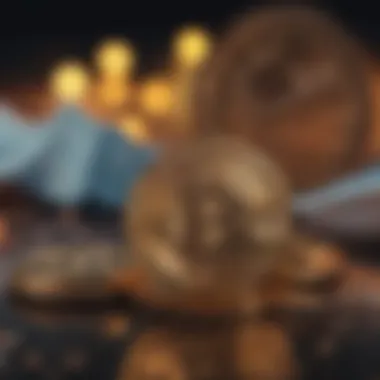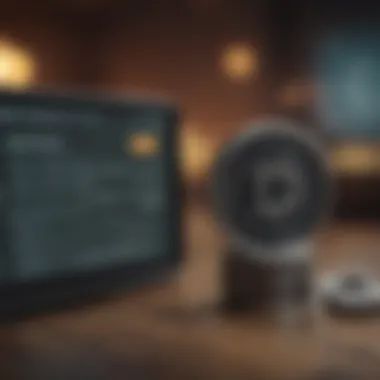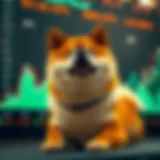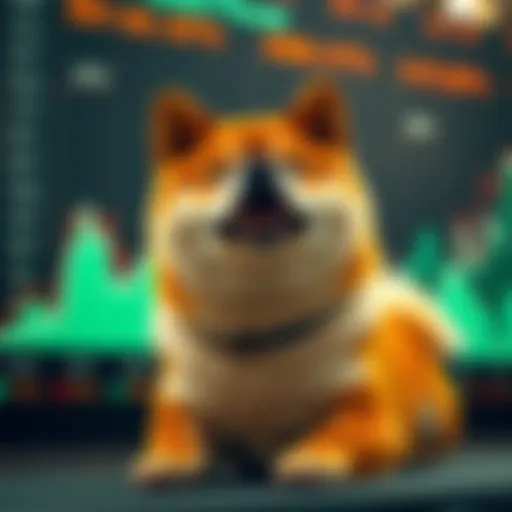A Comprehensive Guide to Purchasing NFTs


Intro
Navigating the digital asset marketplace can feel like trying to find your way through a thick fog without a map. With the rise of non-fungible tokens (NFTs), a whole new world of possibilities has emerged for collectors, investors, and enthusiasts alike. This guide aims to shed light on the journey of purchasing NFTs, ensuring you don’t miss a beat in this dynamic market.
In the past few years, NFTs have gained astounding traction, with digital artworks fetching prices that could make your head spin. Not limited to art, these tokens can represent music, virtual real estate, and much more. As the hype continues, understanding the fundamentals becomes crucial for anyone looking to dip their toes into this digital sphere.
So, what exactly are NFTs? Simply put, they are unique digital assets verified using blockchain technology. Each token holds distinct information, making it a one-of-a-kind item in the vast sea of the internet. But before you dive deeper, let’s break down some pressing market insights that will ground your understanding.
Market Analysis
Current Trends in Cryptocurrency
The landscape of cryptocurrency is always shifting. Currently, the spotlight is on NFTs, with more and more creators and brands jumping aboard the bandwagon. Major platforms, like OpenSea and Rarible, have seen a surge in trading activity, indicating a growing interest in this peer-to-peer exchange of digital assets.
Some key trends to watch:
- Increased Corporate Involvement: Companies are creating branded NFTs to engage with consumers. Coca-Cola and Nike have taken steps to release limited-edition tokens aimed at fandom and collectibles.
- Integration with Social Media: Platforms like Twitter have integrated NFT profiles for users, showcasing their digital collections effortlessly.
- Environmental Awareness: As discussions around the environmental impact of blockchain rise, many projects focus on sustainability, with eco-friendly blockchains gaining popularity.
Price Prediction Techniques
Understanding how to predict price movements in the NFT market is daunting but essential. Here are a few approaches to consider:
- Market Sentiment Analysis: Keep an eye on social media channels like reddit.com or various NFT forums. Community discussions often reflect upcoming trends.
- Historical Data Review: Analyze past sales and price trends using resources like en.wikipedia.org to gauge the value fluctuation of similar NFTs.
- Network Activity Metrics: Platforms that track wallet activity can provide insights into which assets are gaining traction. The more a token is bought and sold, the higher the potential for appreciation.
Understanding these trends can place you one step ahead, making you better equipped to navigate the unpredictable waters of NFTs.
Investment Strategies
Long-Term vs Short-Term Investing
Investing in NFTs can be likened to choosing between a sprint and a marathon. Each approach carries its own set of advantages and risks.
- Long-Term Investments: If you believe in the potential of certain digital artifacts, holding them for an extended period can yield significant returns. This is particularly relevant for established artists or brands with loyal audiences.
- Short-Term Flipping: For the more active trader, flipping NFTs shortly after acquiring them can be lucrative, but it's akin to walking a tightrope. The volatility can lead to quick gains or devastating losses.
Risk Management in Crypto Trading
Like any investment, navigating the NFT realm demands prudence. Here are some strategies to mitigate risks:
- Diversify Your Portfolio: Don’t put all your eggs in one basket. Spread your investments across various types of NFTs – art, collectibles, or gaming assets.
- Set Profit Targets and Stop Losses: Create a clear strategy for when to sell. Having predefined numbers can help you avoid emotional decisions.
- Stay Informed: The NFT market thrives on information. Regularly check industry news and trends on platforms such as facebook.com to keep your knowledge fresh.
In summary, as you embark on your NFT buying journey, staying informed about market dynamics, refining your investment strategies, and understanding the nuances of the marketplace can help you make more informed decisions. Remember, this is a constantly evolving scene, and adaptability is key.
Understanding Non-Fungible Tokens
In the evolving world of digital assets, a solid grasp on Non-Fungible Tokens (NFTs) is crucial. These digital collectibles, each one unique, have created a new paradigm in how we think of ownership and investment. Understanding NFTs allows potential buyers, investors, and even curious tech enthusiasts to navigate this realm with greater confidence. To truly appreciate the NFT ecosystem, it is important to explore what they really are and how they differentiate themselves from traditional forms of currency and assets.
Defining NFTs
At its core, a Non-Fungible Token is a unit of data stored on a blockchain that certifies ownership of a unique item or piece of content. Unlike cryptocurrencies like Bitcoin or Ethereum, which are interchangeable, each NFT is distinct and cannot be exchanged on a one-to-one basis. Think of it like a painting by Picasso; no two paintings are the same. When discussing NFTs, we’re talking about anything from digital artwork, music files, virtual real estate, or even tweets. This uniqueness is what drives their value.
Differences Between NFTs and Cryptocurrencies
While both NFTs and cryptocurrencies utilize blockchain technology, they serve different purposes. Cryptocurrencies are designed to be fungible, meaning that one Bitcoin is worth the same as another Bitcoin, much like a dollar bill. In contrast, NFTs are non-fungible, signifying that their value derives from their unique qualities.
To illustrate this, consider an everyday analogy: if you have two identical sets of keys, you can swap them without any loss of functionality. However, if you own a specific baseball card—let’s say a limited edition—its worth depends on its rarity and demand. You can’t just swap it with any other card; it’s a one-of-a-kind item.
The Technology Behind NFTs
The backbone of NFTs is two critical elements: blockchain technology and smart contracts. Each NFT is recorded on a blockchain, ensuring their provenance and authenticity— this is like a digital certificate of authenticity. Blockchain acts as a decentralized ledger, making it incredibly hard to hack or falsify ownership. Here’s a closer look at the technologies driving NFTs forward.
Blockchain and Smart Contracts
Blockchain provides a secure, transparent framework for NFTs. Unlike traditional databases, a blockchain is maintained across a network of computers, making it resistant to tampering. One of the key characteristics of blockchain is that it enables traceability. This means that you can track the historical ownership of an NFT.
Smart contracts, on the other hand, are self-executing contracts with the terms directly written into lines of code. They facilitate, verify, or enforce the negotiation or performance of a contract. Using smart contracts, creators can define specific conditions, such as royalties on future sales. This makes them a popular choice; they automate transactions and reduce the need for intermediaries.
"Smart contracts bring efficiency to the NFT ecosystem, ensuring fair transactions while minimizing costs for both creators and buyers."
Token Standards Explained
Token standards dictate how NFTs are structured and interact within the blockchain. The most widely adopted standards are ERC-721 and ERC-1155.
The key characteristic of ERC-721 is that it allows for truly unique tokens. Think of it as a passport; each one has its specific identity and properties, which is necessary for making NFTs distinct from one another. On the flip side, ERC-1155 supports both fungible and non-fungible tokens in a single contract. This means users can bundle multiple types of tokens together, enhancing efficiency during transactions.
One unique feature of these token standards is their interconnectivity; for instance, numerous NFTs can be created and sold within a single contract using ERC-1155, reducing the operational complexities for developers. This streamlined approach is a boon for the NFT marketplace, promoting flexibility while lowering costs.


In summary, understanding the definition and key technologies underpinning NFTs opens the door to better decision-making as one navigates the complexities of digital assets, reminding us that while the world of NFTs can be intimidating, it also presents unique opportunities for innovation.
The NFT Marketplace Landscape
Understanding the NFT marketplace is akin to mapping out a unique and often bewildering landscape of digital assets. This section delves into the current marketplace for NFTs, elucidating important facets that every potential buyer should be aware of. The NFT landscape is rich with opportunities but also rife with intricacies that can baffle newcomers and seasoned enthusiasts alike. By exploring various marketplaces, evaluating their features, and understanding distinct characteristics, buyers can make informed decisions, enhancing their chances of success in this dynamic space.
Popular NFT Marketplaces
Within the realm of NFTs, marketplaces serve as the bustling bazaars where creators and collectors converge. Each platform possesses its own unique qualities that cater to different audiences, making the choice of marketplace crucial for buyers.
OpenSea
OpenSea has positioned itself as the giant in the NFT world, resembling a virtual mall overflowing with diverse selections. The platform allows users to trade a plethora of digital assets, ranging from art to virtual real estate. One might say it’s the first stop for anyone interested in NFTs.
- Key Characteristic: Its user-friendly interface enhances the browsing experience, allowing even novices to navigate with ease.
- Unique Feature: OpenSea facilitates the creation and sale of NFTs directly by users, removing barriers often found on other platforms.
- Advantages: With a vast selection of items, it provides ample opportunities for buyers to find unique pieces. However, it is worth noting that the sheer volume can also make it challenging to identify quality items, compelling one to sift through the noise.
Rarible
Rarible distinguishes itself by fostering community participation and decentralization. It acts as a platform not just for buying and selling, but also for creating. Here, users can mint their own NFTs, turning their digital creations into tradable items.
- Key Characteristic: The emphasis on decentralization appeals to those who value community governance and ownership.
- Unique Feature: Rarible's token-based rewards system incentivizes active users, allowing them to earn RARI tokens by participating in platform governance.
- Advantages: This aspect promotes user engagement and loyalty, but it may also confuse buyers unfamiliar with the mechanics of governance tokens and reward systems.
Foundation
Foundation has carved out a niche as a platform catering to artists and curators. The focus here leans heavily on quality over quantity, often showcasing less but more refined collections.
- Key Characteristic: The invite-based model ensures a level of exclusivity, attracting established creators, which in turn can enhance the overall quality of art listed.
- Unique Feature: Its emphasis on curated content creates a unique shopping experience, akin to visiting a high-end gallery.
- Advantages: For buyers looking for specific high-quality works by known artists, Foundation can be a treasure trove. However, the limited availability of new pieces can make it less appealing for those seeking a broader range of options.
Evaluating Marketplace Features
Once you’ve pinpointed potential marketplaces, evaluating their distinct features becomes essential. Various attributes influence your buying experience and could ultimately affect the success of your investment.
User Interface and Experience
A marketplace’s user interface can make or break a buyer’s experience. A well-designed platform contributes to not only ease of navigation but also to overall engagement in the purchasing process.
- Key Characteristic: An intuitive UI reduces the time and effort needed to search for NFTs successfully.
- Unique Feature: Features such as customizable search filters and advanced categorization allow buyers to find what they want without unnecessary hassle.
- Advantages: The better the user experience, the more enjoyable the browsing and purchasing process tends to be, enhancing buyer satisfaction. Conversely, poorly designed interfaces can frustrate users and lead to missed purchasing opportunities.
Transaction Fees and Royalties
Understanding transaction fees and royalties is essential for any buyer looking to calculate potential expenses accurately. Each platform has its own fee structure, which can significantly alter the final cost of a purchase.
- Key Characteristic: Fees often vary with the type of asset being traded and the nature of the transaction (buy/sell).
- Unique Feature: Some marketplaces, like Rarible, include options to set royalties for creators, allowing them to earn from future sales.
- Advantages: An understanding of the fee structures can help buyers choose the most cost-effective platform while ensuring that creators are fairly compensated, crucial for fostering sustainable growth in the NFT ecosystem. However, it’s worth noting that high fees can also eat into potential profits during resale.
Preparation for Buying NFTs
Preparing to buy NFTs is paramount for anyone looking to dip their toes into the digital asset waters. It’s not just about browsing nifty art online; it requires some groundwork to ensure a smooth sailing experience. By establishing a strong foundation before making any purchases, you greatly reduce potential pitfalls and elevate your chances of a successful investment.
There are specific elements that are crucial in this preparatory phase, primarily revolving around creating a secure environment for your assets. Having a well-structured plan allows you to navigate through choices more confidently and can lead to more informed decision-making. Furthermore, understanding the tools and processes can significantly enhance your buying experience in this intricate digital marketplace.
Establishing a Digital Wallet
A digital wallet is the cornerstone of your NFT-buying journey. Think of it like a virtual bank; it's where you hold, manage, and trade your digital assets. There are various types of wallets, and selecting the right one is key.
Types of Wallets
Digital wallets come in a range of forms—hot wallets, cold wallets, and even hardware wallets.
- Hot Wallets: These wallets are connected to the internet, making it easy to access your assets quickly. However, this convenience comes with its share of risks, particularly exposure to hacks.
- Cold Wallets: These are offline wallets used for long-term storage. They offer superior security and are less likely to be targeted, but accessibility is limited to when you have the hardware on hand.
- Hardware Wallets: Devices like Ledger and Trezor can securely hold cryptocurrencies and NFTs. They’re robust against online threats but require a bit of tech know-how to set up and use effectively.
In this article, focusing on both hot and cold wallets is beneficial because it lets potential buyers identify the right balance between convenience and security.
How to Set Up a Wallet
Setting up a digital wallet sound straightforward, but it’s got its nuances. The key characteristic here is the user interface, which should be intuitive yet still provide the necessary features.
- Choose a wallet that fits your needs: Whether you lean towards the convenience of a hot wallet or the security of a cold wallet, find one that resonates with your lifestyle.
- Download or purchase: For hot wallets, download the app; for hardware wallets, make the purchase from a reputable source.
- Follow the prompts: Most wallets offer step-by-step instructions to help you get started. Be mindful to create strong passwords and back your wallet up securely.
In this article, we emphasize the importance of following best practices during wallet setup, as this lays the groundwork for safe transactions.
Acquiring Cryptocurrency
Once your wallet is ready, acquiring cryptocurrency is the next step. It’s akin to filling up your virtual cart before heading to the checkout in a physical store.
Choosing a Cryptocurrency Exchange


Selecting the right cryptocurrency exchange holds significant importance because this platform facilitates your entry into the market. Here, one needs to factor in aspects like user experience, transaction fees, and security options. Not all exchanges are created equal; for instance, some may have complex interfaces or high fees, which can be frustrating for new users.
When considering an exchange, popular options include Coinbase, Binance, and Kraken. These platforms are known for their user-friendly experiences and robust security measures, making them reliable choices.
Buying and Transferring Funds
Buying cryptocurrency involves a few steps, akin to a shopping spree. First, link your bank account or credit card to the exchange, then select the cryptocurrency you wish to buy. After placing an order, funds should be transferred to your digital wallet. This process adds an additional layer of complexity that needs careful attention. Some exchanges take time to process transactions, making it essential to plan ahead, especially if you’re eyeing a particular NFT.
It’s crucial to understand the transaction times and potential fees for transfers, as these factors can impact your purchasing timeline. Being clear about these aspects helps ensure a seamless transition into the NFT realm.
"Planning is bringing the future into the present so that you can do something about it now."
This phase of preparation focuses not only on securing a wallet but also on safely accessing funds to facilitate your NFT purchases. Investigating these topics before embarking will equip you with the insights needed to navigate the digital asset marketplace effectively.
Navigating the Purchase Process
When it comes to diving into the NFT marketplace, navigating the purchase process is essential. This stage not only involves finding suitable NFTs but also grasping the various buying strategies at your disposal. Having a solid understanding of this process empowers buyers by helping them make informed decisions. It can save both time and money in the long run, given the complexities that can arise in this innovative marketplace. All that shine may not be valuable; therefore, a careful approach is paramount.
Finding NFTs to Purchase
Finding the right NFT can feel like searching for a needle in a haystack if you don't know what to look for. This stage involves exploring diverse categories and genres, which play a significant role in narrowing down your options. Each category contains its unique flavor—whether it's digital art, music, collectibles, or virtual land—each facet offers different experiences and values.
Exploring Categories and Genres
Exploring categories and genres allows buyers to broaden their horizons. The NFT market is not homogenous; it comprises various segments, each catering to distinct tastes. For instance, digital art is a hot ticket, drawn by brands such as Beeple and Pak, who have pushed boundaries in how art is created and sold. As well, collectibles have gained their own following, with enthusiasts snapping up virtual versions of traditional items.
The advantage of exploring these categories lies in the ability to find an NFT that resonates personally or aligns with a specific investment strategy. However, diversifying too quickly can dilute focus, making it vital to keep an eye on one's primary objectives.
Using Filters and Search Tools
Navigating the sea of NFTs becomes much more manageable using filters and search tools. Most marketplaces come equipped with these tools, allowing you to sift through vast inventories quickly. A common option is filtering by price, ensuring you stay within your budget.
The key characteristic here is efficiency; these filters save heaps of time that would otherwise be spent scrolling through irrelevant listings. And while the tools are commonly available, not all marketplaces offer robust filtering systems. Thus, it's important to assess how comprehensive these tools are—complex filters may provide a more tailored experience, yet could also lead to analysis paralysis.
Bidding and Buying Strategies
Mastering the bidding and buying strategies can set a buyer apart in the competitive realm of NFTs. Understanding the dynamics of how prices fluctuate and the psychology behind bidding can pave the way for fruitful transactions. Buyers must be armed with knowledge to successfully navigate auctions and fixed prices, as each has its distinct approach.
Understanding Auctions and Fixed Prices
It's essential to distinguish auctions from fixed prices when purchasing NFTs. Auctions create a sense of urgency and competition, drawing bids that can escalate prices quickly. Alternatively, fixed prices offer a straightforward approach, eliminating the unpredictability associated with bidding wars.
Both methods have their merits. Auctions can lead to bargain deals for the astute buyer, while fixed prices provide a level of certainty. The downside of auctions, however, includes the risk of overbidding out of excitement. Therefore, understanding the nuances of both methods becomes critical in crafting a successful purchase strategy.
Setting a Budget and Limits
Setting a budget and limits is arguably one of the most crucial aspects of navigating the purchase process. Having a financial plan helps mitigate impulsive buying, especially amid heated bidding wars. Knowing exactly how much you can afford prevents emotional decisions that may lead to buyer's remorse.
The beauty of setting limits lies in creating a defined approach to your acquisitions. It makes clear how much you truly value a particular NFT, whether it's for personal enjoyment, investment, or both. Notably, while some may view strict budgeting as a hindrance, others find it liberating; it allows for calculated searches without the chaos of a more open-ended system.
"In the world of NFTs, preparation is often the key to success."
By being proactive and strategic in the purchase process, buyers can ensure they have the upper hand as they navigate a landscape rife with opportunity and risk.
Post-Purchase Considerations
Once you've successfully purchased your NFT, there are a few considerations that come into play. It's not just about acquiring digital art or assets; what you do after the purchase can greatly impact your experience and outcomes in the NFT landscape. Understanding how to manage, store, and potentially resell your NFTs is crucial for anyone who wants to derive real value from their digital assets.
Storing and Displaying Your NFT
Best Practices for Digital Asset Storage
Storing your NFT securely is one of those things that can’t be overstated enough. The best practices for digital asset storage hinge on safeguarding your investment from theft or loss. A popular choice among crypto enthusiasts is using a hardware wallet, like Ledger or Trezor. These devices keep your private keys offline, offering a fortress-like protection against cyberattacks.
The key characteristic here is security. Relying solely on online wallets can put your assets at risk, especially if the wallet provider faces a breach. Moreover, having backups of your recovery phrases in safe locations ensures you don’t lose everything due to a simple mishap.
However, using hardware wallets does have its unique features. They require initial setup and can be somewhat cumbersome compared to online options. But these disadvantages are overshadowed by the peace of mind they offer.
How to Showcase Your NFT
Showcasing your NFT is all about displaying your collection effectively. It's about more than just having them in a digital wallet; it’s like having a gallery in your home. You can opt to use platforms like Rarible or Foundation, which allow you to display your assets publicly. This not only flaunts your collection but can also generate interest and leads to potential transactions.
The allure of showcasing your NFTs lies in its visibility. Highlighting your assets can attract buyers or even collaborations, amplifying your presence in the NFT space. There are even virtual reality platforms where you can create immersive galleries that offer a unique experience to viewers.
The unique feature of showcasing in virtual spaces is highly engaging, but it can be complex to navigate if you're not tech-savvy. Still, it’s an intriguing option to consider, especially when you aim to distinguish yourself in a crowded marketplace.


Potential for Resale
Understanding Market Trends
The potential for resale is where it starts to get interesting. Understanding market trends is vital for maximizing the return on your NFT investments. The NFT space is ever-shifting, with new trends emerging frequently. A collector should keep tabs on which categories are hot, whether that's digital art, music, or virtual real estate. Websites and social platforms, like Reddit and various Discord communities, can be valuable resources for gauging upcoming shifts in interests.
The benefit here is knowledge. Knowing when demand spikes or wanes can help you decide whether to hold or sell your NFTs. Moreover, following social media trends can guide your purchases and sales. However, staying informed requires consistent effort and attention, which can be a drawback for those with limited time.
Timing Your Sale
When you decide to sell your NFT can greatly affect your profits. Timing your sale to align with market demand is a nuanced art. It can feel like a dance with uncertainty, as you monitor trends and potential buyers’ interests.
The essential characteristic of timing your sale effectively is market awareness. If you’re paying attention to upcoming events, such as NFT drops or seasonal trends, you can better choose when to promote or list your assets. This is especially important during periods where large NFT sales are scheduled, as these events can trigger heightened interest.
A unique feature to consider is leveraging auction timelines. Auctions can build excitement and lead to higher bids. Yet, auctions come with their own set of risks, as they rely on the right audience being present at the right time. Understanding when and how to capitalize on these elements can yield substantial rewards.
Remember, knowledge isn’t just power; in the NFT world, it can be a direct line to profit.
In wrapping your head around these post-purchase considerations, it becomes evident that the NFT market demands not only enthusiasm but a well-rounded approach to management and future potential. By knowing how to store, showcase, and resell your NFTs, you craft a comprehensive strategy that can unlock the full value of your digital assets.
Understanding the Risks Involved
Purchasing NFTs brings a slew of opportunities, yet these come hand in hand with a variety of risks. It is essential for buyers, from seasoned investors to new enthusiasts, to understand these risks clearly. An awareness of the potential pitfalls can significantly influence decision-making, whether they opt to keep their digital assets or buy and sell on various marketplaces.
Market Volatility
Market volatility in the NFT space can be as unpredictable as a roller coaster ride. Prices can skyrocket for a limited time, only to tumble like a lead balloon shortly afterward. For instance, some artists saw their work sell for millions of dollars when the hype surrounding NFTs peaked, but many later experienced severe price corrections. This aspect can lead to an emotional roller coaster for investors, often resulting in rushed decisions out of fear or greed.
Being proactive about monitoring trends, understanding market cycles, and analyzing past performance can help mitigate some risks. Buyers should be prepared for rapid shifts in value and maintain rationality when faced with fluctuating prices.
Scams and Fraud Prevention
The NFT market, much like the Wild West, has its share of dubious characters looking to make a quick buck. Therefore, having a keen eye for scams is vital for anyone venturing into this territory. The fact that blockchain technology offers anonymity can turn out to be a double-edged sword. On one hand, it enhances security; on the other, it can lead to a rise in fraud and deceit.
Identifying Red Flags
To identify potential red flags one must stay observant. Watch for unusual signs such as unrealistic price drops, the use of generic artwork, or accounts with zero online presence prior to a big sale. These indicators could point to trouble ahead. For buyers, recognizing these flags can serve as a first line of defense against scams. It’s not just precautionary; it’s essential.
Key Characteristics of Identifying Red Flags:
- Attention to Detail: Buyers should, at the very least, scrutinize the digital provenance of the NFTs they aim to buy. A lack of traceable history may hint at possible fraudulent activity.
- Research and Community Involvement: Engaging with community discussions on platforms such as Reddit can also present valuable insights on questionable projects or marketplaces.
Best Practices for Safe Transactions
Let’s focus now on best practices that ensure safety during transactions. As the old saying goes, "better safe than sorry." By following a few guidelines, buyers can help reduce their exposure to scams.
Key Characteristics of Best Practices for Safe Transactions:
- Using Established Marketplaces: Stick to reputable platforms with good ratings. OpenSea and Rarible, for instance, have been thoroughly vetted by the community.
- Double-checking Links and Smart Contract Details: Always verify that you’re interacting with legitimate URLs and contracts. Hackers often create fake websites that look sleek but are just traps waiting to ensnare unsuspecting buyers.
With increasing concerns about fraudulent activities, employing best practices can act like a safety net, ensuring that buyers can navigate the NFT world with more confidence, subsequently making wiser investments.
In summary, understanding the risks tied to buying NFTs is not just optional; it's paramount for anyone serious about investing in this emerging digital frontier. Familiarizing oneself with market nuances and adopting an unwavering awareness of potential scams can pave the way for a more secure and fruitful NFT experience.
The Future of NFTs and Digital Ownership
The significance of exploring the future of NFTs and digital ownership lies in the transformative potential these technologies hold for various industries. As individuals and organizations continue to embrace digital assets, understanding how NFTs can shape ownership models is crucial. This section delves into upcoming trends, applications, and the broader implications for society at large, making it relevant for investors, traders, analysts, and anyone interested in the evolution of technology in commerce.
Emerging Trends in the NFT Space
A whirlwind of activity surrounds the NFT sector, with new trends surfacing at a pace that can leave even the most seasoned observers reeling. One noteworthy trend involves the integration of augmented reality (AR) and virtual reality (VR) with NFTs, allowing users to experience digital assets in a more immersive way. This innovation not only enhances user engagement but also broadens the scope for digital asset creators. Additionally, social media platforms are beginning to cater to digital collectibles, increasing mainstream visibility and acceptance of NFTs.
Furthermore, the concept of fractional ownership is gaining traction, enabling multiple investors to own a fraction of a high-value digital asset. This democratization of asset ownership signifies a shift toward inclusivity, making it feasible for more people to participate in markets that were once exclusive. Overall, emerging trends showcase an evolving landscape that is likely to redefine how ownership and value are perceived in the digital marketplace.
NFTs Beyond Art
Music and Entertainment
The music and entertainment industries are blazing trails with NFTs, representing a significant shift in how artists can monetize their work. Musicians are utilizing NFTs to sell exclusive content such as unreleased tracks, concert tickets, and unique merchandise. This move not only stirs excitement among fans but also ensures that artists can reap the benefits directly, sidestepping traditional intermediaries that often consume a substantial part of revenues.
A key characteristic of this trend is the direct engagement it fosters between artists and their audiences. By offering limited edition NFTs, artists create a sense of exclusivity that fans value, potentially transforming how music is marketed and consumed. However, it also brings forth challenges, such as understanding the proper legal frameworks to manage rights and royalties for digital content.
Virtual Real Estate
Virtual real estate, another burgeoning arena for NFTs, offers intriguing possibilities within online environments like metaverses. This concept revolves around owning virtual land or spaces, facilitating new forms of interaction and commerce in digital realms. Investors are purchasing parcels of virtual land with the intent to develop or resell them, much like traditional real estate markets.
The unique feature of virtual real estate lies in its ability to blend creativity with capital. Owners can build experiences, host events, or create digital storefronts, opening doors for innovative business models. Still, certain disadvantages exist, particularly regarding valuation and developing practical applications for these virtual spaces. Fluctuating demand and market speculation can also impact the perceived value, making thorough research essential for anyone looking to invest.
"As NFTs continue to expand into sectors like music and virtual real estate, they challenge traditional notions of ownership and value, setting the stage for a digital-first future."
In summary, as the NFTs landscape keeps shifting and expanding, keeping an eye on these trends allows investors and participants to navigate this rapidly changing marketplace effectively and make informed decisions.















